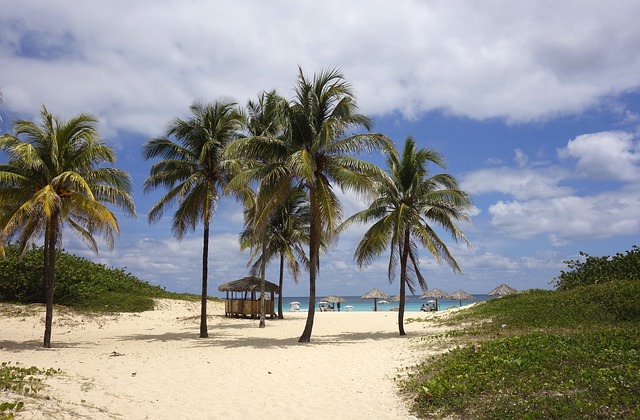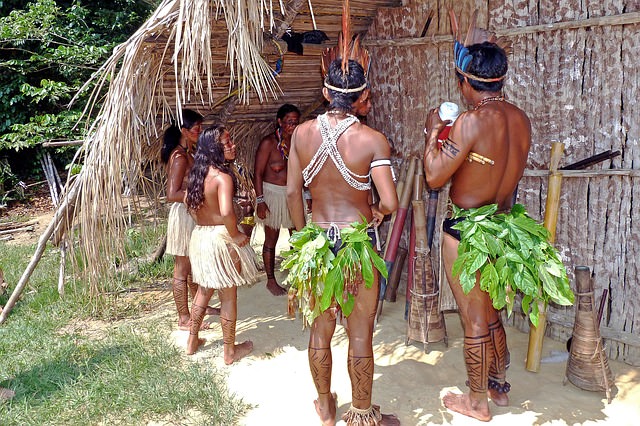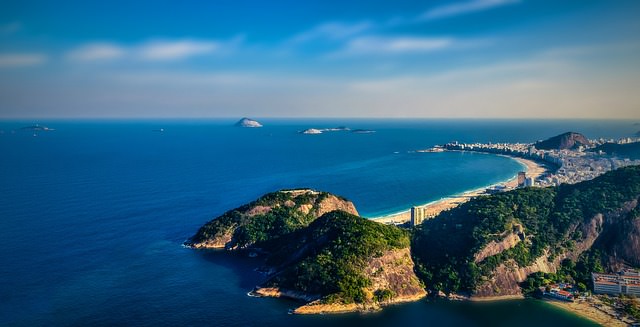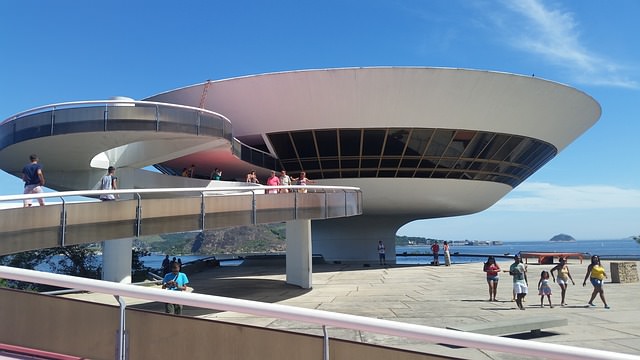Backpacking in Brazil
One of the most versatile travel countries on our planet is Brazil. The country, of which only the dream beaches of Copacabana, Ipanema or the Amazon forest were known in the traveler scene in former times, is moving more and more into the focus of the interest of the travelers. Brazil is multi-faceted in every respect. If you can’t believe it or don’t want to, you should know that it can get really cold in this mostly tropical country.
But grotesquely enough, one has to drive to the south and not to the north like in Europe. As diverse as the geography and the climate is also the culture of the country. Let’s discover together the biggest South American country. We talk about the most beautiful beaches of Brazil, secret travel tips and of course the travel budget.

Backpacking in Brazil Beach
Travelling in Brazil is different
Tourism is becoming increasingly important in Brazil. Almost every region wants to profit from it. There is also a lot to experience. Those who like the cultural and historical heritage of the Portuguese period will discover it in many churches and fortifications throughout the country. If you want to experience the jungle, you have to go into the bushes, what does the bush mean? We are talking about the largest bush in the world. The largest part of Brazil ALWAYS consists of untouched primary virgin forest. Will it stay that way for a long time to come? Let’s hope so. You can go to the Indios or penetrate the swamps in the Pantanal. Each region has something very special to offer.
In 2010, millions of visitors streamed into the country, by 2013 it was already 7 million. But don’t worry, it won’t be crowded. After all, Brazil is as big as Europe. Then you can get out of the way. Many of the visitors get stuck in the strongholds of Rio de Janeiro or Sao Paolo anyway. The Argentinians and Uruguayans, who also arrive in droves in summer, usually stay in the south around the dream island Florianopolis. Those who know such little things can avoid the hustle and bustle, if desired.
However, Brazil also stands for hustle and bustle, fiestas, exuberance, dance and hot samba rhythms. In Brazil there is always something going on. According to the International Congress & Convention Association (ICCA) Brazil is behind the USA, Germany, Spain, England, France and Italy one of the countries with the most events in the year.
Culture in Brazil
If you go to Brazil and not only look out for the beautiful girls and boys, which in Brazilian means Garrotas and Garrotos, but also wanted to experience some Latino culture, then be prepared for something. Such a concentrated load of culture and cultural offer is offered to you in a few countries of the world. Who is wondering why, here countless cultural influences from all countries of the world plus the indigenous cultures meet.
Unfortunately, the interaction is not always harmonious. Hacienderos greedy for money, who sell the Amazon forest for cheap and fast money, stand in permanent conflicts with the partly still untouched living tribes. In addition to Portuguese, another 170 indigenous languages are spoken in Brazil. The most spoken indigenous languages are the language groups tupí, arawak and macro-yê.

Backpacking in Brazil – Amazon indians
Cultural sights in Brazil
You need years to visit all the cultural sights in the giant country. But to get an overview of the absolute highlights, it’s best to click on the UNESCO site with the Brazilian world heritage sites. There you will not only find the most exciting cultural sites, but also some of the hottest travel tips ever. As a little delicacy you will find some more sights on the page below, which might be added to the list once. Better go there now, some are real insider tips. Here is a small list with the top cultural highlights plus some adventure sports in Brazil:
- Capital Brasilia
- Historic city centre Salvador de Bahia
- Historic city centre of São Luís
- Historical city centre Diamantina
- Historic town centre of Goiás
- Historical city centre Olinda
- Historical city centre Ouro Preto
- Jesuit mission of the Guranis in San Ignacio Mini, Santa Ana, ruins of Sao Miguel the Missoes
- Protected area Bom Jesus do Congonhas
- São Francisco Square in the city of São Cristóvão
- Serra da Capivara National Park
- Fernando de Noronha and Atol the Rocas Reserves
- Central Amazon Conservation Complex
- Protected area Chapada dos Veadeiros and the Emas National Parks
- Iguaçu National Park
- Pantanal Conservation Area
- Brazil trip. What is there to note? What is there to keep in mind?
A trip to Brazil is certainly exciting and interesting, but it can also be dangerous. You shouldn’t take the untouched natural jungle lightly, just as you shouldn’t take the urban jungle in the big cities. Concentrate on a few important points during your journey and treat them intensively, instead of just sniffing around everywhere. With the size of Europe, there are many differences in culture and geography to discover.
You can drink mate with the Brazilian Gauchos in the south of the country and live wild and free with the Indians in the Amazon. You can dance samba with the crunchy boys and girls in the dream beaches of Rio de Janeiro. Or move you to Pernambuco to the hot rhythms of Frevo and Maracatu. The region around Bahia is known for the music style Axé Music. And the Bossa Nova by Tom Jobim and Vinicius de Moraes can be heard again and again on the radios or in the bars.
Backpacker Route in Brazil
There are a lot of backpacker routes in Brazil. In this gigantic country you can also avoid each other if you don’t trample on the Lonley Planet Path. Brazil offers you countless combinations of different routes. You can follow the mountains in the south, the gauchos, surf the beaches of Florianopolis, dive on the island of Fernando do Noronha, beat your way through the Amazon or visit the cultural highlights of the country.
As always, when planning the backpacker route, it is crucial how much time and budget is available. Of course, what you want to see is also important. A mixture of culture, adventure and activities in each city or region you would have to find yourself. Of course you can extend or shorten the route according to your wishes. It always depends on how much time you have. But now a few suggestions for a few backpacker routes times with and times without suggestions for activities and trips:
Route 1: The classic (15-20 days)
- 4-5 days: Sao Paulo and Rio de Janeiro
- 3-4 days: Iguazu Waterfalls
- 3-4 days: Salvador – the former capital and the former slave metropolis
- 2-3 days: surfing on one of the 34 beaches around the island Florianopolis
- 3-5 days: hanging out and diving on the island of Fernando do Noronha
- Enjoy 1 day or night nightlife and beachlife in Fortaleza
- 3-6 days Amazonas
- 3 days of surfing paradise and hippie village Jericoacoara experience
Route 2: All or Nothing ( 32-42 days)
The above goals are also part of the trip here
- 1-2 days: Historic city centre Diamantina
- 1-2 days: Historical city centre of Goiás
- 1-2 days: Historic city centre Olinda
- 3-4 days: boat trip and riding tours through the Pantanal
- 6-7 days: Kaiman observation tour in the jungle near Manaus
- 2 -3 days: Canyon landscape Chapada dos Guimaraes,
- 1-2 days: A jungle hike to get to know the diversity of the Amazon rainforest.
- 2-3 days: River island Marajó
- 2-3 days: Lençois Maranhenses National Park
- 2-3 days: Trekking in the canyon landscape of the Chapada Diamantina
- 2-3 days: Oktoberfest in Blumenau in the state of Santa Catarina.
- 3-4 days: Sand surfing, rafting and whale watching in the state of Santa Catarina.
Travel times in Brazil
The climate does not underestimate in any case. In the south of the country it can get cold in the winter there (July, August) minus 10 degrees. In places like Bahía, in the north, it pisses all year round. But especially from May to July. In the jungle it is always hot and humid. So you should have the right clothes with you for all seasons.
Backpacker Budget in Brazil
So one thing is clear, Brazil is not cheap. Traveling and staying overnight is even expensive. You have to adjust to at least Western European standards when planning your budget. The price increase started one or two years before the 2014 World Cup. Since the 2016 Olympic Games will also be held there, the country has adjusted to more tourists and investors.
The result was seen during the 2014 World Cup. The prices went up, but the wages and incomes of the locals remained behind. Social inequality increased and now backpackers and tourists also have to pay a high price for their visit. Here are a few details on the travel budget:
Daily budget per person about 66 Euro
- Accommodation 10-40 Euro
- Food 4 Euro
- Water 2 Euro
- Public transport 7 Euro
- Overland transport 23 Euro
Cheap in Brazil Travel
Breakfast is included in the hotel room. With a total of 10 Euro including drinks you can get through if you are very economical. If you lay down between 20 Euro and 40 Euro per head, you can afford a certain luxury with a double room and bathroom. However, in Río or on the Fernando de Noronha archipelago it will be difficult to find anything in the classroom. Everything that goes over it is then already something for the travelers with a better filled bag. Here is a short overview of the prices in Sao Paolo.
- Bus, train subway ticket simply 1 Euro
- Café in a bar middle class 2,2 Euro
- Daily menu restaurant middle class 12 Euro
- Beer in a pub middle class 3 Euro 0,33 cl.
- One litre fuel 1,2 Euro
- Taxi from the airport to the city 53 Euro – 40 minutes
- Cinema admission at the weekend 9 Euro
If you want to take care of yourself, you can take a look here at one of the big supermarket chains in the country for the current food prices. On the Brazilian cheap flight site voeazul a price comparison between bus trips and domestic flights in Brazil was posted. Here are a few examples:
The flight from Rio de Janeiro to Porto Alegre takes two hours, with the bus you are 20 hours on the way. The cost of a flight is 93 euros, while the bus costs 77 euros.
From Belo Horizonte to Salvador the bus takes 14 hours and the plane 2 hours. The flight costs 100 Euro, the bus about 70 Euro. You can also look around for other cheap airlines in Brazil.
The prices vary, because the competition is big. You can find offers at Webjet, Avianca and GOL. It’s worthwhile to have a look at the biggest Brazilian airline TAM every now and then. Unfortunately, some of the pages are only in Portuguese. Fare in the bus is about 3-5 Euro per hour travel time. Departure of the intercity buses takes place only at the bus stations.
Backpacker Accommodation in Brazil
It’s up to you whether you want to stay in typical pousadas, noble or less noble hotels or natural lodges. Brazil offers you in this respect a large selection of overnight accommodations. Everyone knows hostels or hostals and knows what to do with the terms campsite and hotel. But what is a pousada? There are masses of them in Brazil. Where there are no hotels, you often meet pousadas.
These hostels can be extraordinarily luxurious but also quite simple and yet super good. The difference isn’t quite clear to us either, as the service is not the same as in a 5-star hotel, but it can certainly come close to the other categories. Some also have the title “Hotel Pousada” plus the name. Thus not completely simply. But it is worthwhile to have a look if one is there at the moment. You are never safe from pleasant surprises.
But you can be sure that you will hardly ever get a real bargain in Brazil. The country is in and expensive. Quite in contrast to Bolivia, where everything is spot cheap. At least you have to adjust to a European price level when it comes to accommodation costs in Brazil. At Hostelworld you will find a good overview of the average price for a bed in a dorm in Brazil.
- 12 Euro Rio de Janeiro
- 13 Euro Sao Paulo
- 10 Euro Florianopolis
- 15 Euro Salvador
- 11 Euro FozdoIguacu
- 14 Euro Ilha Grande
- 13 Euro Paraty
- 13 Euro Buzios
- 13 Euro Curitiba
- 13 Euro Belo Horizonte
As I said, that’s the cut. If you’re looking, you’ll find something cheaper. You can also camp in Brazil quite well. Along the coast and also in different national parks as for example in Iguacu you can already camp. The campsites are well equipped and quite inexpensive. Usually Wifi is also included. There are also remote campsites that offer only a minimum of comfort (e.g. no hot water). On the other hand, these campsites in particular are often located in charming natural landscapes. There is an Argentinean travel site (no panic is in Spanish, but the coordinates are the same all over the world), where you can discover numerous campsites from the north to the south. You also have the GPS data with you. Oh yes. Something else. Better you do not descend in a motel. This is a kind of sex hotel.
Backpacker Trips, Tips & Highlights in Brazil
If you are looking for destinations in Brazil, you should consider exactly what you want to do. Especially when only a certain time limit is available. Some spend the whole Brazil vacation only in Rio de Janeiro with the Barhopping and at the Copacabana or Ipanema. Others cut themselves into the dense bushes of the Amazonasurwald. A boat trip through the Amazon jungle from Manaus already has something.
Those who go to the Pantanal will not only encounter the world’s largest swamp landscape, but will also be surprised by a huge biodiversity. Horny islands as Fernando de Noronha, the Ilhadomel or the Ilha Grande are also worthwhile destinations where you will meet some real dream beaches.
Speaking of dream beaches in Brazil. You better stay away from the tourist beaches in the big cities. There is not much romance and beach flair there. Looks like Rimini in the high season. You don’t need to go to Brazil to the beach for that. I’ll tell you a few really horny beaches in Brazil. Here you should go.

Backpacking in Brazi lRio
The most beautiful beaches in Brazil
Macaio near Alagoas
At Porto Seguro the beaches around Espelho. Romantic cabins for overnight stays are also available.
Morro de São Paulo, in the very north of the island of Tinhare. The beaches around Florianopolis. Also at Barra de laghoa. Pure surfing. Cruising on the Ilha Grande to the hidden beaches of Aventureiros and Parnaioca by boat.
Diving, snorkeling and beach paradise Fernando de Noronha. Near Bahia Itacaré and the small bays Engenhoca, Jeribucaçu beside some others. Pure surfing also here. According to the Washington Post, the beaches around Jericoacoara are among the 10 best in the world. 85 km from Natal, the dream beaches of Pipa await your visit. Also good, the beaches of Buzios.
Backpacker Highlights in Brazil
If you want to experience the Brazilian Gauchos, yes there are also, then you have to go to the region of Rio Grande do Sul and here especially to the Sierra Gaúcha in the south towards Uruguay. But it can also get very cold there. So be careful at which time of the year you travel. Best in October to December and then from March to June. In Lençóis Maranhenses you will find an incredible dune landscape in which crystal clear lakes form during the rainy season.
If you want to experience life on or near the Amazon, visit the small town of Alter do Chão in the state of Pará, which is part of the Santarém area. Here you also have the opportunity to make a long trip to the Amazon. Of course, the mighty Iguazu waterfalls at the border to Argentina are always worthwhile. The best way to get there is to fly from Rio.

Backpacking in Brazil
Train driving in Brazil
A great adventure are the train rides in Brazil. There are some worthwhile tourist trains that cross charming landscapes. So you can take the almost 50 km long train track from Pindamonhangaba in the Valle de Paraiba to CamposdoJordão, which runs right through the Sierra de Mantiqueira. Departure daily.
The probably most beautiful trip goes from Curitiba to Marumbi / Morretes / Paranagua. The route, which has been used since 1880, winds its way through the Serra doMar for over 110 km. It goes through 13 tunnels and over 41 bridges, through dense forests and past bubbling waterfalls.
Hiking and adventure in Brazil
Climbing and trekking are excellent in the Serrados Orgãos National Park. Agulha do Diabo is one of the 15 best rock climbing spots in the world. Other cool locations in this respect are São Bentodo Sapucaí, Serra do Cipó in the province of Belo Horizonte and Tres Picos-Salinas in the state of Rio de Janeiro. An unforgettable rafting adventure awaits you in the north of Jalapão. Also in Brotas, in the south of the country, trekking tours, climbing, white water rafting await you.
The same applies to the towns of Chapada Diamantina and Deliro Gouveia. In the Serras Gauchas, which reach to the neighboring country Uruguay, you can ride with the Brazilian Gauchos through the endless pampas steppes. In Chapadados Guimaraes, inland, you’ll find numerous caves to explore. The Serrado Cipo also has a lot to offer to boost your adrenaline.

Backpacking in Brazil Museum
Food and Drinks in Brazil
Brazilian cuisine is as rich as the whole culture and geographical diversity of the country. It is no wonder that, over the centuries, immigrants from all over the world have flocked to Brazil. Added to this are the different geographical conditions in the interior, in the heights and on the coasts, which have produced a completely different food culture. Basically, Brazilian cuisine is based on three pillars: indigenous, African and European. While the indigenous people rely on pure natural food, using dishes made of manioc, corn, flour, and caught fish and game meat and fruits from the respective region, the African slaves feed on beans, rice, couscous.
They hardly hunted at all, but raised livestock and cultivated crops. German, Spanish and Portuguese cuisine has a major influence on contemporary Brazilian cuisine. But Italian cuisine is also rooted in it. The German roots lie above all in the rich south, in the federal state of Santa Catarina. The daily meals of an average Brazilian consist of the café-da-manhã (morning coffee) after getting up, that can also be a milk coffee (café-com-leite) and bread (pão) with sausage etc..
Then there are some fruits here and there, and later in the evening for jantar (dinner) the dish feijão com arroz (beans with rice). But also sometimes a vegetable soup with meat inlays or a meat dish, which in many cases is prepared grilled. The feijoada is regarded as the national dish. This is a bean stew with meat, to which rice, Farofa from cassava and a few orange slices are served as decoration.
In the north you should try Carurú. These are sautéed prawns with a hot sauce made of red pepper, okra, onions, tomatoes, chilli and palm oil. Or you can try a tacacá. This is a soup made from the juice of the cassava root with crabs. Around Bahia the dish Moqueca is popular. It is a stew with fish or crabs. Acarajé is a typical dish of Afro-Brazilian cuisine. The small balls of ground beans, crabs and spices fried in oil taste really delicious. To celebrate, the popular Caipirinha is overthrown. The stuff is delicious, but causes severe headaches. If you want to get fit again, drink Guaraná juice.
Backpacker Visa and Vaccinations in Brazil
According to the Foreign Office, the entry requirements for Germans to Brazil are as follows. Travel documents for entry into Brazil are possible for German citizens with the following documents:
- Passport: Yes
- Provisional passport: Yes
- Identity card: No
- Temporary identity card: No
- Children’s passport: Yes
Comments: Travel documents must be valid for at least six months upon entry. Children’s entries in a parent’s passport are no longer valid as of 26.06.2012. Each child needs his or her own identity document. Anyone can stay in Brazil without a visa for three months within six months, after which they have to leave the country for half a year.
Vaccinations and medical advice
Vaccination against yellow fever should be available, but it does not have to be. Dengue is widespread, as is malaria. There is no malaria on the coasts around Fortaleza, Recife, Igauçu and most city centres. The Federal Foreign Office recommends to complete the standard vaccinations.
